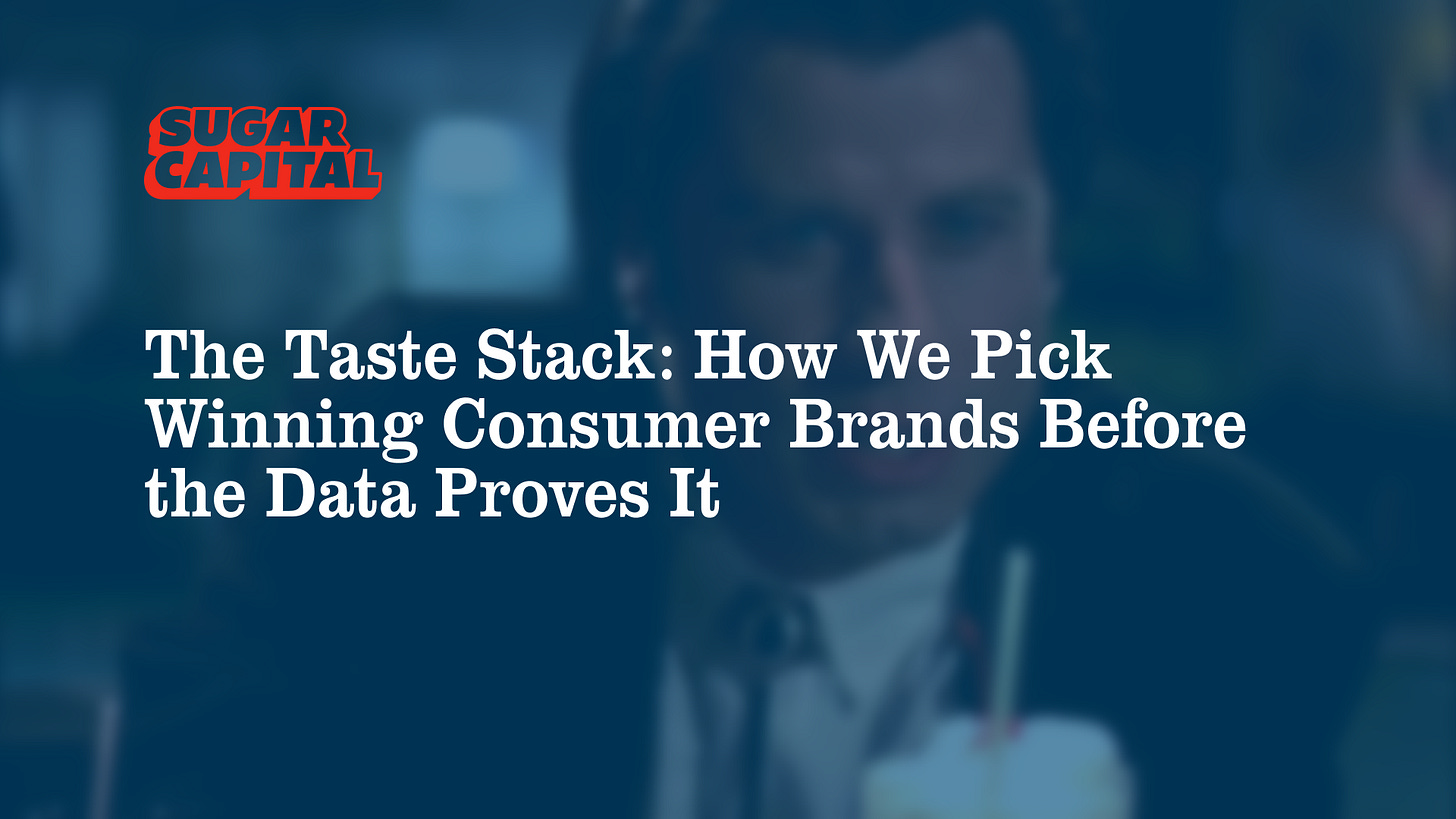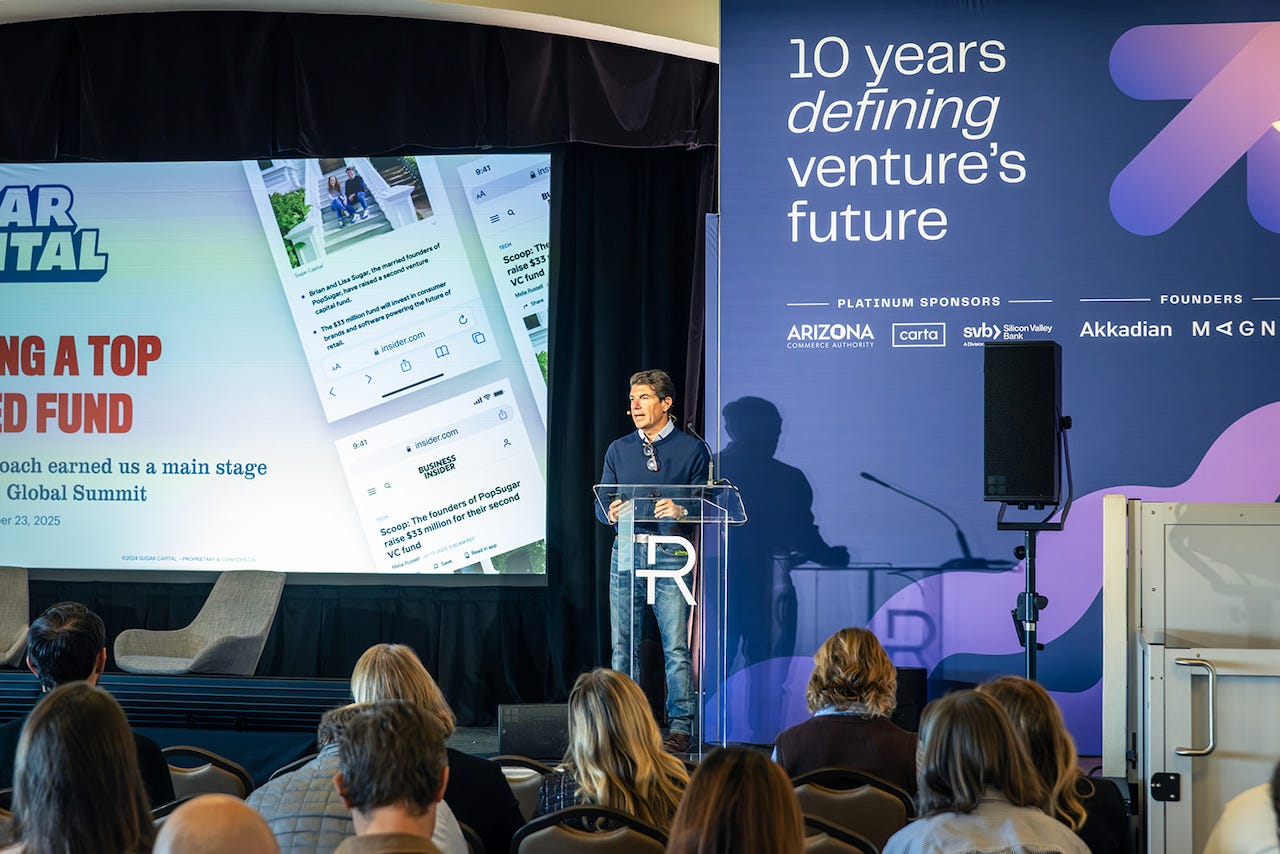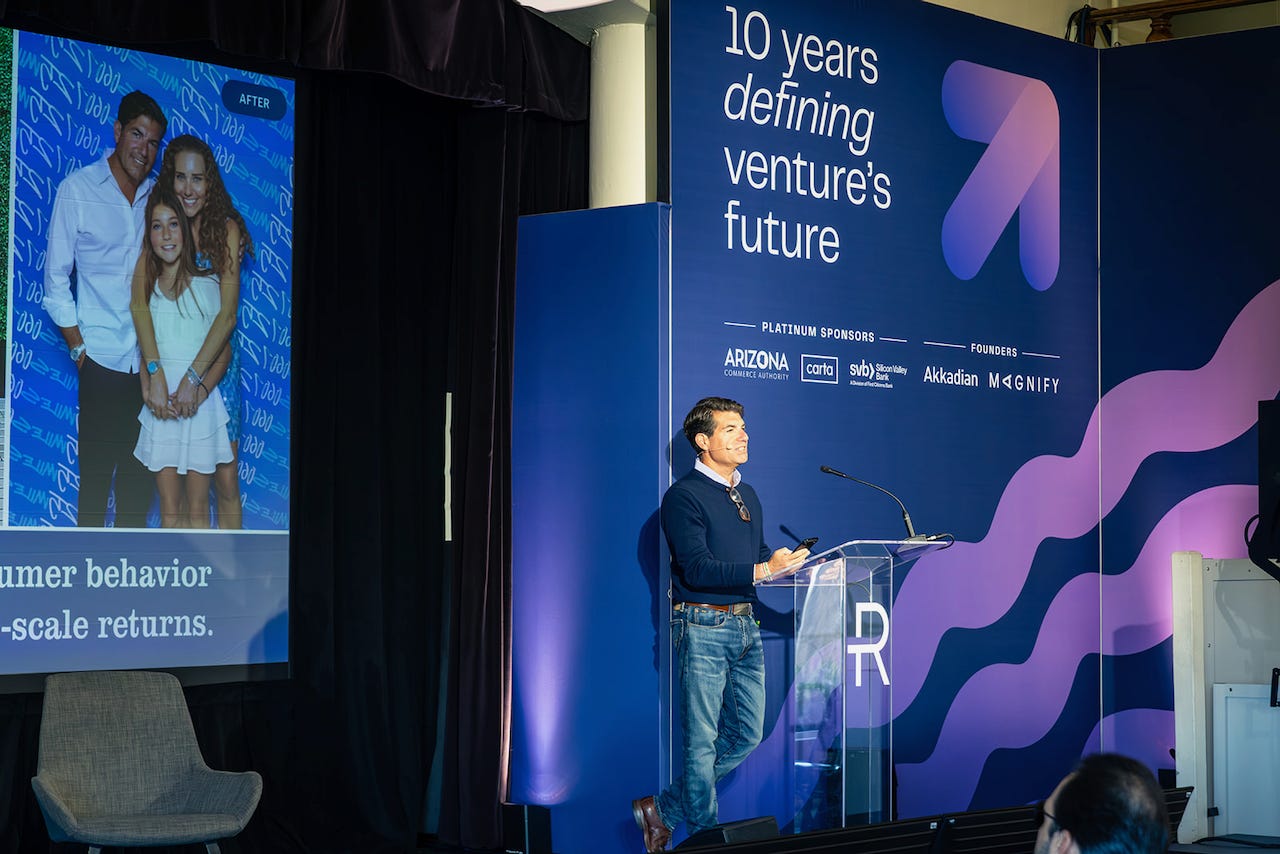The Taste Stack: How We Pick Winning Consumer Brands Before the Data Proves It
Why cultural intelligence beats financial analysis in early-stage consumer investing
“That’s a pretty fucking good milkshake. I don’t know if it’s worth five dollars, but it’s pretty fucking good.” — Vincent, Pulp Fiction (1994)
Just got to NYC for the Equal’s Emerging Manager Summit at The Wythe Hotel in Brooklyn. Rick and the team at Equal always put on a fantastic event.
Last week at The Presidio in San Francisco, I presented Sugar Capital to three hundred LPs at the RAISE Global Summit. Over a thousand GPs applied. One hundred were invited. Twenty-four presented on the main stage. We were one of them.
The three-minute presentation went well, or so I think. People photographed my slides, which I’m told is a sign of affection. The meetings afterward were better.
But in every conversation, the same question surfaced: How do you know?
How did we spot Grüns when it was just gummy vitamins? How did we see Starface turning acne patches into fashion statements? How do you pick consumer winners with no data?
The honest answer makes people uncomfortable: we knew because we have taste.
Not mystical intuition. Not lucky guesses. Taste as systematic cultural intelligence, a framework for understanding behavior that most VCs don’t know how to build.
Most venture firms approach consumer investing with tools designed for enterprise software. They model five-year projections. They calculate TAMs from outdated Nielsen data. They worship CAC and LTV ratios that mean nothing before product-market fit. It’s analytics theater.
By the time a brand generates enough data to satisfy these models, the opportunity is gone. The valuation is too high, the outcome predetermined, the return impossible.
Others swing to the opposite extreme. They claim consumer investing is pure instinct, something you’re born with or pick up in the right social circles. That’s not a method. That’s an excuse.
The real edge lives between those extremes. Pattern recognition trained on culture, not spreadsheets. Most investors predict behavior through financial proxies while the real signals live in Reddit threads, Instagram comments, TikTok feeds, Discord servers, product reviews, and unsolicited word of mouth. The zeitgeist isn’t in quarterly reports. It’s in the cultural texture most investors never bother to read.
At Sugar Capital, we’ve systematized what looks like intuition into a repeatable framework, what we call The Taste Stack™️. Six signals we track before we ever look at a single metric.
Language Drift. How are people describing their needs differently than they did six months ago? Language shifts before behavior does. Before Grüns existed, consumers had stopped saying “I should take my vitamins” and started saying “I can’t deal with mixing another powder.” That linguistic shift told us the category was ready to crack.
Aesthetic Divergence. Visual choices aren’t decoration. They’re declarations of identity. Starface’s yellow stars rejected fifty years of shame-based acne marketing in a single design choice. When a generation gravitates toward specific aesthetics, they’re not following trends. They’re declaring values.
Friction Audits. We study pain points incumbents dismiss as unsolvable or unprofitable. Snif recognized that buying fragrance online had become anxiety theater while retail felt increasingly pretentious. The friction was enormous. The solution required courage, not capital.
Community Formation. Micro-communities gathering around shared frustrations are leading indicators. We track which subreddits are accelerating, which Discord servers are activating, which TikTok niches are maturing. Before Caraway launched, communities were already gathering around toxic cookware, discussing PFAS in non-stick coatings, searching for alternatives. Markets don’t create communities. Communities create markets.
Adjacent Proof. Consumer trends echo across categories before they become obvious. Ingredient transparency succeeded in skincare, then predicted reformulation in snacks and beverages. Probiotics worked in yogurt, then kombucha, proving prebiotics would work in sodas like Poppi and OLIPOP. When patterns succeed in one space, they migrate to adjacent ones. You just have to listen.
Native Fluency. You can feel this in the first meeting. Tourists study customers through focus groups. Natives describe lived frustration. This quality can’t be hired, faked, or taught. It’s earned through experience in the culture you’re serving.
When we met Grüns, there was almost no data to analyze. Just launched, minimal revenue, another supplement brand in a commoditized category facing giants with infinite budgets. But the cultural signals were clear. Language had shifted from virtue to burden. The wellness aesthetic was splitting between clinical and playful. The friction wasn’t efficacy, it was consistency. Communities were forming around sustainable habits instead of extreme protocols. Functional foods were winning by hiding nutrition in formats people already loved.
The founder wasn’t an industry veteran. Chad was a frustrated consumer building what he wished existed.
We invested early, before meaningful revenue. The unit economics validated later. But the cultural conditions were already set. We weren’t betting on a product. We were betting on inevitability.
The brands breaking out now prove the thesis. Rhode hit a billion-dollar valuation in three years. Grüns in under two. Poppi exited at $1.65 billion. None of these companies built demand from scratch. They spotted genuine cultural inflection points, built products native to those shifts, and paired cultural inevitability with financial discipline.
This is the opposite of DTC 1.0, the era when founders mistook marketing for moats and storytelling for strategy. The new generation of winners blends what rarely coexisted before: taste and discipline, cultural intelligence and capital efficiency, inevitability and profitability. Both, not either.
Taste compounds. The more brands you evaluate through these signals, the faster you spot patterns. The more you immerse yourself in the edges of culture, the earlier you detect movement. This is why POPSUGAR wasn’t a detour from investing, it was twenty years of training. Lisa and I didn’t just track culture, we helped shape it. We built a media company that moved what millions cared about before they knew it themselves. POPSUGAR became a Jeopardy! answer. That’s not a media milestone. That’s cultural permanence. You don’t become a trivia question by following trends. You become one by setting them.
The Taste Stack™ is the codification of that lived experience, two decades of predicting human behavior at scale, refined into a system for spotting the next generation of inevitable brands. You can’t shortcut the reps. You can commit to better inputs. TikTok comment sections over analyst reports. Creator communities over consultant decks. What people are newly obsessed with, quietly ashamed of, or texting friends about unprompted over what they already buy.
Here’s what most investors won’t admit: they’re afraid of being wrong about taste, so they wait for data to make the decision for them. By then, the outcome is already determined. The founders who understand their cultural moment with native fluency are building right now. They’re reading signals most investors can’t see. Your job is to recognize them before the data makes it obvious.
That’s what the LPs at RAISE really wanted to understand. Not how we got lucky.
How we built a system to see what others miss.
Taste isn’t magic. It’s method.





Good Taste, buen gusto en español. Simple pero poderozo concepto
You have a sixth sense💋